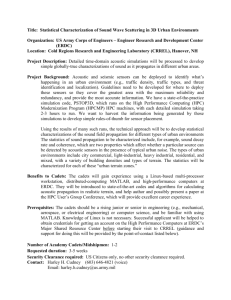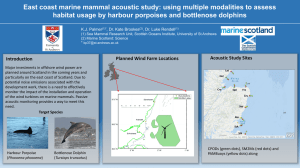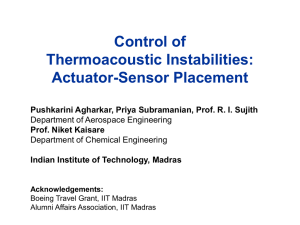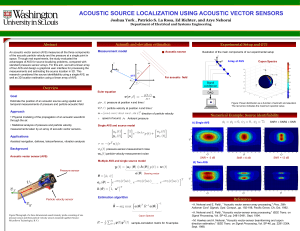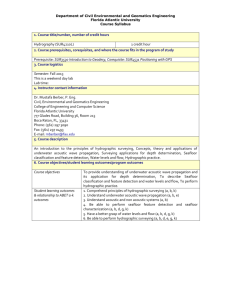Demonstrating the style for the Journal of Physics
advertisement
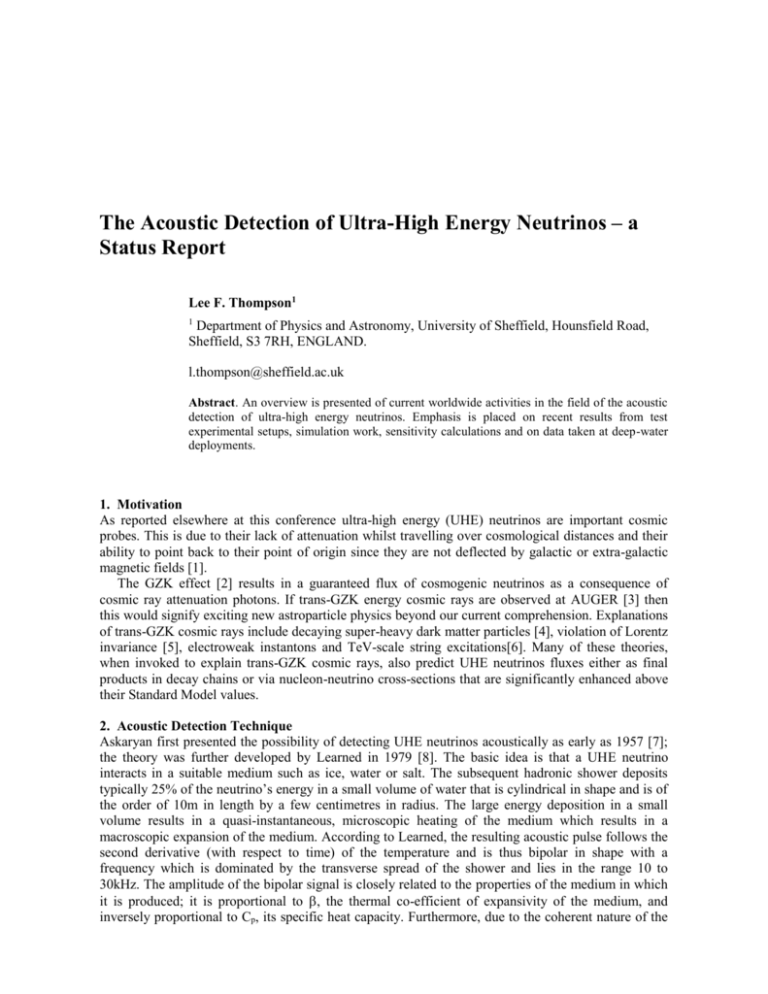
The Acoustic Detection of Ultra-High Energy Neutrinos – a Status Report Lee F. Thompson1 1 Department of Physics and Astronomy, University of Sheffield, Hounsfield Road, Sheffield, S3 7RH, ENGLAND. l.thompson@sheffield.ac.uk Abstract. An overview is presented of current worldwide activities in the field of the acoustic detection of ultra-high energy neutrinos. Emphasis is placed on recent results from test experimental setups, simulation work, sensitivity calculations and on data taken at deep-water deployments. 1. Motivation As reported elsewhere at this conference ultra-high energy (UHE) neutrinos are important cosmic probes. This is due to their lack of attenuation whilst travelling over cosmological distances and their ability to point back to their point of origin since they are not deflected by galactic or extra-galactic magnetic fields [1]. The GZK effect [2] results in a guaranteed flux of cosmogenic neutrinos as a consequence of cosmic ray attenuation photons. If trans-GZK energy cosmic rays are observed at AUGER [3] then this would signify exciting new astroparticle physics beyond our current comprehension. Explanations of trans-GZK cosmic rays include decaying super-heavy dark matter particles [4], violation of Lorentz invariance [5], electroweak instantons and TeV-scale string excitations[6]. Many of these theories, when invoked to explain trans-GZK cosmic rays, also predict UHE neutrinos fluxes either as final products in decay chains or via nucleon-neutrino cross-sections that are significantly enhanced above their Standard Model values. 2. Acoustic Detection Technique Askaryan first presented the possibility of detecting UHE neutrinos acoustically as early as 1957 [7]; the theory was further developed by Learned in 1979 [8]. The basic idea is that a UHE neutrino interacts in a suitable medium such as ice, water or salt. The subsequent hadronic shower deposits typically 25% of the neutrino’s energy in a small volume of water that is cylindrical in shape and is of the order of 10m in length by a few centimetres in radius. The large energy deposition in a small volume results in a quasi-instantaneous, microscopic heating of the medium which results in a macroscopic expansion of the medium. According to Learned, the resulting acoustic pulse follows the second derivative (with respect to time) of the temperature and is thus bipolar in shape with a frequency which is dominated by the transverse spread of the shower and lies in the range 10 to 30kHz. The amplitude of the bipolar signal is closely related to the properties of the medium in which it is produced; it is proportional to , the thermal co-efficient of expansivity of the medium, and inversely proportional to Cp, its specific heat capacity. Furthermore, due to the coherent nature of the energy deposition along a trajectory co-linear with the neutrino it can be shown that the predicted neutrino pulse is expected to lie in a plane or “pancake” perpendicular to the neutrino direction. This is a further characteristic of a neutrino-induced acoustic signal and is analogous to the diffraction of light through a narrow slit. In the frequency range of interest acoustic pulses can travel large distances in a medium such as ice, water or salt. This leads to the prospect of potentially huge effective volume neutrino detectors being built from relatively sparsely spaced arrays of acoustic sensors such as hydrophones. The remainder of this paper is dedicated to a status report of activities in the field of acoustic detection. 3. Simulation Work The CORSIKA software [9] suite, which is used to generate UHE cosmic ray showers in the atmosphere, has recently been modified to generate UHE neutrinos in water [10]. Extensive crosschecks against GEANT [11] have been made the aim being to use the subsequent parametrisations of CORSIKA events to produce simulated acoustic signals in water. 4. Current Acoustic Sites At present no dedicated large area acoustic sensor array for UHE neutrino detection exists. However important data have been taken at a number of sites which include existing military arrays and dedicated small-scale deployments. These include: 4.1. SAUND and SAUND II The AUTEC naval array comprises a large number of wide band hydrophones deployed in relatively deep water (~1500m) off the Eastern coast of Andros Island in the Bahamas. Between 2003 and 2004 the SAUND (Study of Acoustic Ultra-high energy Neutrino Detection) collaboration recorded 195 days of data reading out 7 hydrophones at the site. This led to the first (and, currently, the only) limit of a UHE neutrino flux being derived from acoustic detection data as is illustrated in Figure 1 [12]. Recently the collaboration has been successful in obtaining funds for SAUND II where 49 hydrophones are being read out. Data taking started in June 2006. 4.2. Lake Baikal The Baikal collaboration has a long history of deployment of optical sensors for the detection of optical Cerenkov photons from high-energy neutrinos. A number of acoustic related initiatives have taken place in parallel with this work. In 2002 and 2003 data were taken that required a co-incidence between scintillators placed on the surface of the frozen lake and acoustic sensors deployed beneath the ice. Analysis of these data has been recently presented [13]. In April 2006 an autonomous unit comprising four hydrophones was deployed at Lake Baikal. Data from this device is expected in 2007. 4.3. ONDE ONDE, the Ocean Noise Detection Experiment was deployed at the NEMO test site off the coast of Sicily in January 2005. ONDE comprises four hydrophones arranged on a pyramidal-shaped mounting; data are taken for 5 minutes every hour. A significant study of noise has been performed as a function of variables such as time of day, year, etc [14]. An example of the noise spectrum measured on one of the hydrophones is given in Figure 2 where it is compared against the expected spectrum for two different sea states. 4.4. ACORNE The ACORNE (Acoustic Cosmic Ray Neutrino Experiment) collaboration has access to a military ranging array of hydrophones situated off the coast of Rona in North West Scotland. In December 2005 eight hydrophones were instrumented and read out continuously at 140kHz sampling rate for two weeks. The resulting data have been analysed using a number of signal processing techniques [15]. Average noise spectra for all eight hydrophones have been measured and spectrographs for the datataking period have been plotted showing possibly biological noise activity. In September 2006 the ACORNE group updated the data acquisition system at Rona to one which would permit continuous data taking of all eight hydrophones. Figure 1: Measured SAUND limit as a function of neutrino flux and energy [12]. Figure 2: Example ONDE data - measured noise spectrum on one hydrophone [14]. 5. Future Acoustic Detection Projects In addition to the activities at the sites mentioned above there are significant acoustic R&D programmes taking place in connection with the current and next generation optical Cerenkov telescopes in the Mediterranean Sea and at the South Pole. These activities are described below. 5.1. Acoustic Detection in ANTARES The ANTARES neutrino telescope is presently under construction in the Mediterranean Sea [16]. In the first half of 2007 it is planned to deploy an instrumentation line that will have a number of “acoustic modules”(AMs). The design of these AMs is to be finalized but one possibility is to take the 17” pressure-resistant glass spheres that currently house the ANTARES PMTs and to replace the PMT with a number of acoustic sensors glued directly to the inside of the glass surface [17]. 5.2. SPATS The South Pole Acoustic Test Setup (SPATS) has been established to research and test acoustic devices for inclusion in the IceCube neutrino telescope. At least 3 IceCube lines are foreseen to be deployed with acoustic components including transmitters and receivers. This is part of a long-term programme of work aimed to develop a possible hybrid neutrino telescope encompassing the multiple technologies of optical, radio and acoustic detection. Earlier in 2006 extensive tests of the SPATS acoustic stages were successfully carried out at Lake Tornetrask in Abisko, Sweden [18]. 6. Sensor Development and Sensor Calibration Whilst good quality wide-band hydrophones are commercially available they are, in general, expensive. This has led some groups to consider the development of acoustic sensors “in house” in order to reduce the capital costs of a future large volume acoustic array. The design of bespoke hydrophones with a response well matched to the expected bipolar acoustic signal requires a good theoretical understanding of the piezoelectric sensor and its coupling. A number of techniques have been employed including the use of equivalent circuits and the use of partial differential equations to describe the microscopic properties of the piezoelectric material. Such equations can be solved using finite element analysis and checked experimentally using laser interferometry. Figure 3 gives examples of the results from these studies [19, 20]. Figure 3: (left) comparison of measured sensor behaviour and finite element simulation; (right) comparison between finite element and equivalent circuit simulations [19]. Precise acoustic sensor calibration, in particular detailed phase and amplitude response, as a function of frequency is also clearly desirable. The SPATS team has recently performed a calibration of more than 70 acoustic sensors in a large water volume (78m x 10m x 5m) using a fully calibrated reference hydrophone and a broadband transmitter [18]. In those cases where such a large water volume isn’t available, other techniques offering sensor calibration include the reciprocity method which involves taking four measurements with 3 uncalibrated hydrophones ideally in the far field [21]. 7. Acoustic Calibration As discussed earlier the acoustic signal from a UHE neutrino is expected to be bipolar in shape and to sit in a “pancake” which is perpendicular to the neutrino’s direction. It is particularly important to study the response of any hydrophone array to such an acoustic signal; this requires an acoustic calibrator comprising one or more acoustic transmitters that reproduce the expected acoustic signal. Figure 4: (left) predicted and observed response of a hydrophone to a sine wave pulse (beyond 0.125ms reflections are observed); (right) excitation pulse and observed bipolar pulse [22]. The ACORNE group has developed a technique to produce a bipolar pulse shape with one hydrophone [22]. The method involves characterising the hydrophone’s response via an equivalent circuit (5th order LRC model) by applying a known signal such as a square wave. The validity of this step is tested by comparing the predicted and actual hydrophone response to a different pulse shape, e.g. a sine wave, as shown in Figure 4 (left). Finally the required excitation pulse to create a bipolar acoustic pulse is calculated. This step is shown in Figure 4 (right) which shows the detected signal, which is bipolar in shape. Further studies have been carried out to estimate the number of coherent transmitters required, in a 10m long volume of water, in order to accurately reproduce the expected “pancake”. These studies indicate a minimum of 6 and ideally 10 transmitting elements along the path length. 8. Sensitivity Calculations A number of studies have taken place to evaluate the sensitivity of the acoustic technique as a function of the parameters of a possible future acoustic sensor array. In Figure 5 the predicted effective volume for a 1 km3 array equipped with ANTARES style sensors is presented as a function of the number of sensors per unit volume [23]. The conclusion is that for a 5 mPa detection threshold increasing the sensor density above 200 per km3 sees no improvement in effective volume. Another study concentrating on detecting the hadronic component of the neutrino cascade in water has estimated the sensitivity after five years of running with a 5 mPa threshold [24]. Figure 6 depicts the results of this study for two possible numbers of randomly distributed sensors, detection thresholds and exposure times. Figure 5: effective area vs. neutrino energy for different densities of acoustic sensors [23]. Figure 6: sensitivity estimates for (A) 1000 hydrophones, 35mPa, 1 year and (B) 5000 hydrophones, 5mPa, 5 years [24]. Recent studies of the acoustic detection of neutrinos in ice have been extended to possible hybrid detectors which encompass optical (O), radio (R) and acoustic (A) neutrino detection. As can be seen in Figure 7 such arrays might centre on a core of strings on which the optical components are concentrated. The sensitivity of such arrays is illustrated in Figure 8; up to 20 events per year could be seen across the hybrid detector which would offer the potential for cross-calibration of signals from the different technologies [25]. 9. Conclusions and Outlook Since the last TeV Particle Astrophysics conference significant progress has been made in the arena of acoustic detection of UHE neutrinos. Simulation work has progressed and a neutrino-friendly version of CORSIKA has been developed. A number of detailed sensitivity studies have been carried out which confirm the possibility of sensitivity to UHE neutrinos with large volume acoustic sensor arrays. Sensor measurements and calibration techniques continue to mature and in situ acoustic calibration techniques show great promise. The SAUND collaboration is now taking data with a significantly larger array of hydrophones and other groups have taken data which will aid the understanding of noise and the development of signal processing algorithms. In the short term the deployment of dedicated acoustic devices are expected in both ice (SPATS) and water (ANTARES) as the exciting prospect of large volume hybrid neutrino detectors involving optical, radio and acoustic technologies draws nearer. Figure 7: Possible hybrid detector configuration [25]. Figure 8: Effective area as a function of neutrino energy for a hybrid detector [25]. References [1] Tom Weiler, J. Phys.: Conf. Ser. 60 (2006) [2] Kenneth Greisen, Phys. Rev. Lett. 16 (1966) 748 G.T. Zatsepin & V.A. Kuzmin, Pis'ma Zh. Eksp. Teor. Fiz. 4 (1966) 114 [3] Jim Cronin, J. Phys.: Conf. Ser. 60 (2006) [4] See, e.g., H. Ziaeepour, http://arxiv.org/pdf/astro-ph/0406079 (2004) [5] See, e.g. J.W. Moffatt, http://arxiv.org/pdf/hep-th/0211167 (2002) [6] Ina Sarcevic, J. Phys.: Conf. Ser. 60 (2006) [7] G. A. Askaryan, J. At. Energy 3 (1957) 921. [8] John G. Learned, Phys. Rev. D 19 (1979) 3293. [9] Dieter Heck et al., Forschungszentrum Karlsruhe Report FZKA 6019 (1998) [10] Terry Sloan, proceedings of the ARENA 2006 conference, J. Phys. Conf. Ser. [11] S. Agostinelli et al., Nuclear Instruments and Methods A 506 (2003) 250 [12] Nikolai G. Lehtinen et al., Astrophysical Journal 621 Part 1 (2005) 301 [13] Vladimir Lyashuk, proceedings of the ARENA 2006 conference, J. Phys. Conf. Ser. [14] Giorgio Riccobene, J. Phys.: Conf. Ser. 60 (2006) [15] Sean Danaher, Proceedings of ARENA 2005 (World Scientific, 2005) 75 [16] Paschal Coyle, J. Phys.: Conf. Ser. 60 (2006) [17] Kay Graf, J. Phys.: Conf. Ser. 60 (2006) [18] Stefan Hundertmark, J. Phys.: Conf. Ser. 60 (2006) [19] Karsten Salomon, proceedings of the ARENA 2006 conference, J. Phys. Conf. Ser. [20] Christopher Naumann, proceedings of the ARENA 2006 conference, J. Phys. Conf. Ser. [21] Miguel Ardid, proceedings of the ARENA 2006 conference, J. Phys. Conf. Ser. [22] Lee F. Thompson. proceedings of the ARENA 2006 conference, J. Phys. Conf. Ser. [23] Timo Karg, PhD thesis, http://arxiv.org/pdf/astro-ph/0608312 [24] Jon Perkin, proceedings of the ARENA 2006 conference, J. Phys. Conf. Ser. [25] Dave Z. Besson et al., http://arxiv.org/pdf/astro-ph/0512604 Justin Vandenbroucke, J. Phys.: Conf. Ser. 60 (2006)
